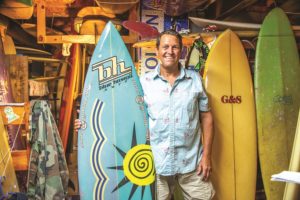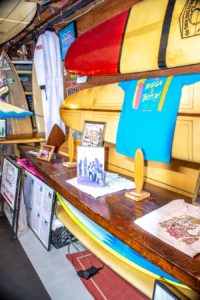Ken Merrill’s first encounter with a surfboard did not go well. He was at Eastham’s Coast Guard Beach, on a borrowed board. “I got sandbagged a few times,” he says. “But I loved it.”
It didn’t take long for him to become part of the Cape Cod Surf Riders Long Board Club, which was started by his kahuna, Mark O’Connell, and included Merrill and his three brothers, Paul, Barry, and Dave. It was the mid-1980s. They surfed and they partied on the Outer Cape’s back shore. The Incredible Casuals, of Beachcomber fame, was their live soundtrack.
Merrill bought his first surfboard — a bright orange nine-foot six-inch longboard emblazoned with the word Caribbean in big letters — in 1986. He paid $30 for it. Today, he says, he wouldn’t sell it for less than $500. But the thing is, he probably wouldn’t sell it. Because, over the years, Merrill has become more than a surfer. He’s a collector.

It was Ken’s brother Dave “Sparky” Merrill who first got into buying vintage boards. “The Sparky Merrill Best Old Board Award” at the annual Oldtimers longboard contest was named for him. After Dave died young — in a motorcycle accident in 1988 — Ken began to build on his brother’s collection, creating what he calls the Cape Cod Surfrider Museum, now housed in his South Dennis basement.
There, boards stand upright, lining the walls, hang from the ceiling, lie on tables, and are stacked lengthwise. Merrill’s collection now numbers more than 150 vintage boards dating back as far as the 1940s, though most are from the heyday of surfboard production in the 1960s and ’70s.
Bright colors, originally mixed in the fiberglass but later done as airbrush art, cover the boards in a wild mixture of images and letters. One labeled “Blue Hawaii” is dominated by a playful abstract figure, another sports a map of Australia, there’s one covered in a pattern reminiscent of William Morris wallpaper, while another’s flowers are in the style of Henri Rousseau’s Polynesia paintings.
One of the surfboard pioneers in the U.S. was Tom Blake, who designed boards in the 1920s and ’30s. His boards are of hollow wood and 13 feet long. He was the first to add a fin in 1932. Merrill’s collection includes a wooden board made in 1945, based on Blake’s design. Longboards ruled until around 1968, Merrill says, when Australians arrived in Hawaii with their newly designed shorter boards.

Merrill’s collection is dominated by longboards made by Dewey Weber, most of which he acquired from Jasper’s Surf Shop in Eastham. Though there have been some buying roadtrips. On one, Merrill and his brother Paul visited a seller in New Hampshire who had hung the board above a table upon which rested a belt-loaded machine gun surrounded by miscellaneous knives and a few hand grenades. They bought the board.
Merrill has a couple of boards made by Challenger Surfboards East, a manufacturer that operated on the Jersey Shore in the 1960s. Its claim to fame is that Bruce Springsteen worked there (or, according to some sources, lived there) and his Steel Mill band practiced there.
One of Ken’s boards has three labels that read “Surfboards by Phil.” Phil Sauer’s boards were used in films — Ride the Wild Surf and Muscle Beach Party — and one played a role in the television version of Gidget.
Boards made by Skip Fry, according to Merrill, may be among the most sought-after examples in his collection. But he especially prizes two that were made by Wellfleet’s Shawn Vecchione, who hand shapes boards in his shop in Orleans. He’s also attached to his Jerry Lopez Lightning Bolt board from the 1970s.
While many of Merrill’s boards are works of art, they also reveal innovation in design. Boards may be single, dual, tri, or quad fin (tri being the most popular today), and the fins may resemble a “D,” a hatchet, a dog bone, or a number of shark fin designs. The ends of the boards themselves also vary. He has examples of pin tail, fish tail, square tail, and swallow tail designs.

Merrill has two dreams for his boards. The first is that they’ll become part of a public surfboard museum. The other is to publish a book on the collection, and the stories behind his acquisitions.
Still, for Merrill it’s not just about the boards. He won “most improved surfer” at the Surf Rider Club contest in 1989. And even though it took another 21 years before he placed at the Oldtimers, he’s come a long way since those early days of being dumped in the beach break at Truro’s Head of the Meadow.
“As my collection grew,” Merrill says, “so did my love of surfing.”



